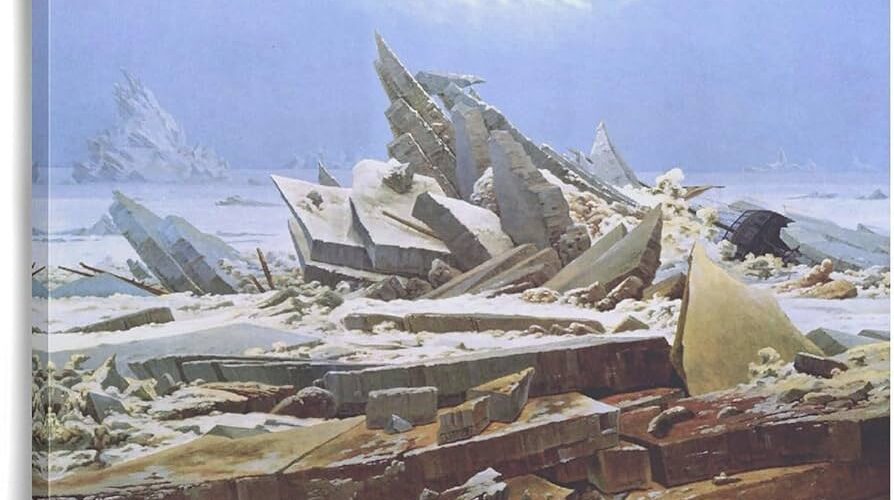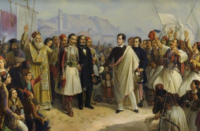The French Revolution sparked great hopes for the rise of the bourgeoisie, the abolition of feudal structures, and the establishment of a capitalist society. Napoleon centralised power in his person, established an authoritarian regime, and crowned himself emperor in 1804. His wars in Europe served both territorial expansion and the spread of capitalist production relations. The events of 1806, including the defeats of the Prussian army at Jena and Auerstedt, the dissolution of the Holy Roman Empire, and the occupation of German territories by French troops, led to a strong anti-Napoleonic freedom movement in Germany.
Caspar David Friedrich was deeply affected by these events, and national themes shaped his art. It was these national traits, which made sense in the context of the Napoleonic Wars, that were later instrumentalised in a different historical context for the purposes of German fascism. His allegories of death and resurrection often transport a patriotic character. Moreover, his work is imbued with poignant melancholy and solitude, reflecting the mood of the time.
Friedrich, the son of a soap boiler, lived and worked in Dresden, the center of early Romanticism. Growing resistance in the occupied territories culminated in the War of the Sixth Coalition. The united forces of the restorative European powers, including Britain, Russia, Prussia, and Austria, finally defeated Napoleon and restored the old order.
The restoration had profound effects on the population and freedom of expression in Germany. Draconian censorship ensured that only government-compliant content was published. The suppression of liberal and national ideas fostered national consciousness and the desire for a united and liberal Germany. Accompanying the encoded artworks that sought to expose the reaction, the escapism of Biedermeier emerged: the retreat, the flight into the private, domestic, and apolitical. The pressure on artists of the time to conform to this was great. But not everyone bowed to it.
Friedrich’s paintingThe Sea of Ice (1823-24) was created during this time of Restoration. Huge, sharp-edged ice floes rising at pyramidal angles dominate the center of the image, conveying a sense of mortal threat. The ice blocks seem to tilt and break in different directions. The repeating, broken shapes of the ice blocks create a visual rhythm that underscores the chaotic and threatening nature of the scene. Irregular and sharp-edged structures convey a sense of chaos and destruction.
The horizontal planes of the ice masses convey stability and suggest an endless expanse of the icy landscape. The low-set horizon line also emphasises the vastness of the sea of ice and enhances the feeling of isolation and infinity. The sky, dominated by ice blocks, reinforces the sense of oppressive power. The contrast between the calm, horizontal planes and the dynamic, vertical forms creates a visual tension that moves the viewer’s eye back and forth, drawing them into the scene and creating an intense emotional experience.
The absence of people reinforces the feeling of loneliness and abandonment. An all but sunk ship, crushed by the masses of ice, symbolises failure and destruction. As a metaphor for the world and human life, it has ended a hell of ice.
The floes in the foreground form a piled-up structure, repeated by similar ice formations in the middle and distant background. These steeply left-leaning slabs resemble deadly high mountain cliffs and suggest past sailing ships frozen into the ice, victims of the eternal cold. The counter-movement of smaller right-leaning ice peaks enhances the impression of the relentless crushing of all life, supported by the huge, brown horizontal slabs in the foreground. Mentally extending the lines reaching left and right, they converge at the stern of the capsized ship—a dark point amidst the many white shades of the frozen sea.
Viewers observe the scene from the shore: the brown color of the foreground floes and remnants of earth indicate this. However, the earth shows no signs of life, and thin trunks of dead trees protrude from the ice. There is no escape from this relentless, all-encompassing ice. Artist and observer each face the icy desert alone. In the original painting, a barely visible star can be found in the upper right part, offering a small glimmer of hope amidst the relentless freezing and destruction of the sea of ice.
After Friedrich’s rapid rise during the Wars of Liberation, where he became known for his works aimed at a liberated German republic, he quickly fell out of favour with the political and cultural scene after 1815. When he turned against the princes, he was ostracised along with others of his views. These rulers fought vehemently against any efforts towards national unity that could have endangered their power in the years following 1815. Instead of giving in to the pressure and turning to anti-democratic or unpolitical Biedermeier themes, Friedrich resisted the Metternich Restoration by continuing to portray shattered hopes.
Friedrich’s critical stance made him so unpopular with the authorities that he did not receive the professorship for landscape painting at the Dresden Academy in 1824 during the new appointment because his influence on the youth was feared. Not only in the academic world but also in public consciousness, the artist was increasingly suppressed and could only survive financially thanks to the support of Russian art connoisseurs. His works, including six significant paintings in the Hermitage, found recognition there.
Friedrich experienced a brief moment of hope during the Dresden uprisings in 1830. But after their defeat, his paintings became even darker. When Friedrich died in Dresden in 1840, he was poor and largely forgotten until the early 20th century. Friedrich’s rebellion in a time of greatest repression and pressure on artists to join the establishment remains relevant to this day.






